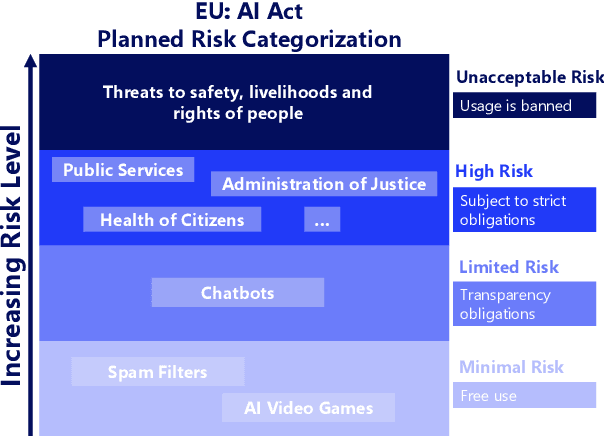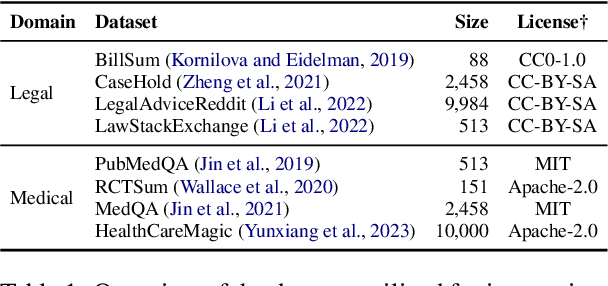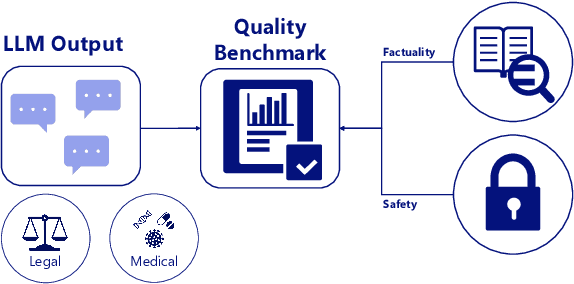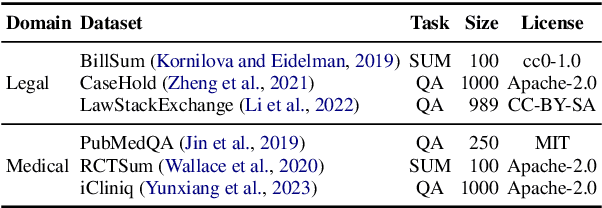Carolin Lawrence
Scaling Evaluation-time Compute with Reasoning Models as Process Evaluators
Mar 25, 2025Abstract:As language model (LM) outputs get more and more natural, it is becoming more difficult than ever to evaluate their quality. Simultaneously, increasing LMs' "thinking" time through scaling test-time compute has proven an effective technique to solve challenging problems in domains such as math and code. This raises a natural question: can an LM's evaluation capability also be improved by spending more test-time compute? To answer this, we investigate employing reasoning models-LMs that natively generate long chain-of-thought reasoning-as evaluators. Specifically, we examine methods to leverage more test-time compute by (1) using reasoning models, and (2) prompting these models to evaluate not only the response as a whole (i.e., outcome evaluation) but also assess each step in the response separately (i.e., process evaluation). In experiments, we observe that the evaluator's performance improves monotonically when generating more reasoning tokens, similar to the trends observed in LM-based generation. Furthermore, we use these more accurate evaluators to rerank multiple generations, and demonstrate that spending more compute at evaluation time can be as effective as using more compute at generation time in improving an LM's problem-solving capability.
Not-Just-Scaling Laws: Towards a Better Understanding of the Downstream Impact of Language Model Design Decisions
Mar 05, 2025Abstract:Improvements in language model capabilities are often attributed to increasing model size or training data, but in some cases smaller models trained on curated data or with different architectural decisions can outperform larger ones trained on more tokens. What accounts for this? To quantify the impact of these design choices, we meta-analyze 92 open-source pretrained models across a wide array of scales, including state-of-the-art open-weights models as well as less performant models and those with less conventional design decisions. We find that by incorporating features besides model size and number of training tokens, we can achieve a relative 3-28% increase in ability to predict downstream performance compared with using scale alone. Analysis of model design decisions reveal insights into data composition, such as the trade-off between language and code tasks at 15-25\% code, as well as the better performance of some architectural decisions such as choosing rotary over learned embeddings. Broadly, our framework lays a foundation for more systematic investigation of how model development choices shape final capabilities.
MEDDxAgent: A Unified Modular Agent Framework for Explainable Automatic Differential Diagnosis
Feb 26, 2025Abstract:Differential Diagnosis (DDx) is a fundamental yet complex aspect of clinical decision-making, in which physicians iteratively refine a ranked list of possible diseases based on symptoms, antecedents, and medical knowledge. While recent advances in large language models have shown promise in supporting DDx, existing approaches face key limitations, including single-dataset evaluations, isolated optimization of components, unrealistic assumptions about complete patient profiles, and single-attempt diagnosis. We introduce a Modular Explainable DDx Agent (MEDDxAgent) framework designed for interactive DDx, where diagnostic reasoning evolves through iterative learning, rather than assuming a complete patient profile is accessible. MEDDxAgent integrates three modular components: (1) an orchestrator (DDxDriver), (2) a history taking simulator, and (3) two specialized agents for knowledge retrieval and diagnosis strategy. To ensure robust evaluation, we introduce a comprehensive DDx benchmark covering respiratory, skin, and rare diseases. We analyze single-turn diagnostic approaches and demonstrate the importance of iterative refinement when patient profiles are not available at the outset. Our broad evaluation demonstrates that MEDDxAgent achieves over 10% accuracy improvements in interactive DDx across both large and small LLMs, while offering critical explainability into its diagnostic reasoning process.
Evaluating Language Models as Synthetic Data Generators
Dec 04, 2024



Abstract:Given the increasing use of synthetic data in language model (LM) post-training, an LM's ability to generate high-quality data has become nearly as crucial as its ability to solve problems directly. While prior works have focused on developing effective data generation methods, they lack systematic comparison of different LMs as data generators in a unified setting. To address this gap, we propose AgoraBench, a benchmark that provides standardized settings and metrics to evaluate LMs' data generation abilities. Through synthesizing 1.26 million training instances using 6 LMs and training 99 student models, we uncover key insights about LMs' data generation capabilities. First, we observe that LMs exhibit distinct strengths. For instance, GPT-4o excels at generating new problems, while Claude-3.5-Sonnet performs better at enhancing existing ones. Furthermore, our analysis reveals that an LM's data generation ability doesn't necessarily correlate with its problem-solving ability. Instead, multiple intrinsic features of data quality-including response quality, perplexity, and instruction difficulty-collectively serve as better indicators. Finally, we demonstrate that strategic choices in output format and cost-conscious model selection significantly impact data generation effectiveness.
AgentQuest: A Modular Benchmark Framework to Measure Progress and Improve LLM Agents
Apr 09, 2024Abstract:The advances made by Large Language Models (LLMs) have led to the pursuit of LLM agents that can solve intricate, multi-step reasoning tasks. As with any research pursuit, benchmarking and evaluation are key corner stones to efficient and reliable progress. However, existing benchmarks are often narrow and simply compute overall task success. To face these issues, we propose AgentQuest -- a framework where (i) both benchmarks and metrics are modular and easily extensible through well documented and easy-to-use APIs; (ii) we offer two new evaluation metrics that can reliably track LLM agent progress while solving a task. We exemplify the utility of the metrics on two use cases wherein we identify common failure points and refine the agent architecture to obtain a significant performance increase. Together with the research community, we hope to extend AgentQuest further and therefore we make it available under https://github.com/nec-research/agentquest.
Walking a Tightrope -- Evaluating Large Language Models in High-Risk Domains
Nov 25, 2023



Abstract:High-risk domains pose unique challenges that require language models to provide accurate and safe responses. Despite the great success of large language models (LLMs), such as ChatGPT and its variants, their performance in high-risk domains remains unclear. Our study delves into an in-depth analysis of the performance of instruction-tuned LLMs, focusing on factual accuracy and safety adherence. To comprehensively assess the capabilities of LLMs, we conduct experiments on six NLP datasets including question answering and summarization tasks within two high-risk domains: legal and medical. Further qualitative analysis highlights the existing limitations inherent in current LLMs when evaluating in high-risk domains. This underscores the essential nature of not only improving LLM capabilities but also prioritizing the refinement of domain-specific metrics, and embracing a more human-centric approach to enhance safety and factual reliability. Our findings advance the field toward the concerns of properly evaluating LLMs in high-risk domains, aiming to steer the adaptability of LLMs in fulfilling societal obligations and aligning with forthcoming regulations, such as the EU AI Act.
Linking Surface Facts to Large-Scale Knowledge Graphs
Oct 23, 2023



Abstract:Open Information Extraction (OIE) methods extract facts from natural language text in the form of ("subject"; "relation"; "object") triples. These facts are, however, merely surface forms, the ambiguity of which impedes their downstream usage; e.g., the surface phrase "Michael Jordan" may refer to either the former basketball player or the university professor. Knowledge Graphs (KGs), on the other hand, contain facts in a canonical (i.e., unambiguous) form, but their coverage is limited by a static schema (i.e., a fixed set of entities and predicates). To bridge this gap, we need the best of both worlds: (i) high coverage of free-text OIEs, and (ii) semantic precision (i.e., monosemy) of KGs. In order to achieve this goal, we propose a new benchmark with novel evaluation protocols that can, for example, measure fact linking performance on a granular triple slot level, while also measuring if a system has the ability to recognize that a surface form has no match in the existing KG. Our extensive evaluation of several baselines show that detection of out-of-KG entities and predicates is more difficult than accurate linking to existing ones, thus calling for more research efforts on this difficult task. We publicly release all resources (data, benchmark and code) on https://github.com/nec-research/fact-linking.
Large Language Models Enable Few-Shot Clustering
Jul 02, 2023Abstract:Unlike traditional unsupervised clustering, semi-supervised clustering allows users to provide meaningful structure to the data, which helps the clustering algorithm to match the user's intent. Existing approaches to semi-supervised clustering require a significant amount of feedback from an expert to improve the clusters. In this paper, we ask whether a large language model can amplify an expert's guidance to enable query-efficient, few-shot semi-supervised text clustering. We show that LLMs are surprisingly effective at improving clustering. We explore three stages where LLMs can be incorporated into clustering: before clustering (improving input features), during clustering (by providing constraints to the clusterer), and after clustering (using LLMs post-correction). We find incorporating LLMs in the first two stages can routinely provide significant improvements in cluster quality, and that LLMs enable a user to make trade-offs between cost and accuracy to produce desired clusters. We release our code and LLM prompts for the public to use.
Uncertainty Propagation in Node Classification
Apr 03, 2023Abstract:Quantifying predictive uncertainty of neural networks has recently attracted increasing attention. In this work, we focus on measuring uncertainty of graph neural networks (GNNs) for the task of node classification. Most existing GNNs model message passing among nodes. The messages are often deterministic. Questions naturally arise: Does there exist uncertainty in the messages? How could we propagate such uncertainty over a graph together with messages? To address these issues, we propose a Bayesian uncertainty propagation (BUP) method, which embeds GNNs in a Bayesian modeling framework, and models predictive uncertainty of node classification with Bayesian confidence of predictive probability and uncertainty of messages. Our method proposes a novel uncertainty propagation mechanism inspired by Gaussian models. Moreover, we present an uncertainty oriented loss for node classification that allows the GNNs to clearly integrate predictive uncertainty in learning procedure. Consequently, the training examples with large predictive uncertainty will be penalized. We demonstrate the BUP with respect to prediction reliability and out-of-distribution (OOD) predictions. The learned uncertainty is also analyzed in depth. The relations between uncertainty and graph topology, as well as predictive uncertainty in the OOD cases are investigated with extensive experiments. The empirical results with popular benchmark datasets demonstrate the superior performance of the proposed method.
State-Regularized Recurrent Neural Networks to Extract Automata and Explain Predictions
Dec 10, 2022Abstract:Recurrent neural networks are a widely used class of neural architectures. They have, however, two shortcomings. First, they are often treated as black-box models and as such it is difficult to understand what exactly they learn as well as how they arrive at a particular prediction. Second, they tend to work poorly on sequences requiring long-term memorization, despite having this capacity in principle. We aim to address both shortcomings with a class of recurrent networks that use a stochastic state transition mechanism between cell applications. This mechanism, which we term state-regularization, makes RNNs transition between a finite set of learnable states. We evaluate state-regularized RNNs on (1) regular languages for the purpose of automata extraction; (2) non-regular languages such as balanced parentheses and palindromes where external memory is required; and (3) real-word sequence learning tasks for sentiment analysis, visual object recognition and text categorisation. We show that state-regularization (a) simplifies the extraction of finite state automata that display an RNN's state transition dynamic; (b) forces RNNs to operate more like automata with external memory and less like finite state machines, which potentiality leads to a more structural memory; (c) leads to better interpretability and explainability of RNNs by leveraging the probabilistic finite state transition mechanism over time steps.
 Add to Chrome
Add to Chrome Add to Firefox
Add to Firefox Add to Edge
Add to Edge